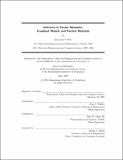| dc.contributor.advisor | Alan S. Willsky and John W. Fisher, III. | en_US |
| dc.contributor.author | Ihler, Alexander T. (Alexander Thomas), 1976- | en_US |
| dc.contributor.other | Massachusetts Institute of Technology. Dept. of Electrical Engineering and Computer Science. | en_US |
| dc.date.accessioned | 2006-06-20T12:56:21Z | |
| dc.date.available | 2006-06-20T12:56:21Z | |
| dc.date.copyright | 2005 | en_US |
| dc.date.issued | 2005 | en_US |
| dc.identifier.uri | http://hdl.handle.net/1721.1/33206 | |
| dc.description | Thesis (Ph. D.)--Massachusetts Institute of Technology, Dept. of Electrical Engineering and Computer Science, 2005. | en_US |
| dc.description | This electronic version was submitted by the student author. The certified thesis is available in the Institute Archives and Special Collections. | en_US |
| dc.description | Includes bibliographical references (p. 175-183). | en_US |
| dc.description.abstract | Sensor networks have quickly risen in importance over the last several years to become an active field of research, full of difficult problems and applications. At the same time, graphical models have shown themselves to be an extremely useful formalism for describing the underlying statistical structure of problems for sensor networks. In part, this is due to a number of efficient methods for solving inference problems defined on graphical models, but even more important is the fact that many of these methods (such as belief propagation) can be interpreted as a set of message passing operations, for which it is not difficult to describe a simple, distributed architecture in which each sensor performs local processing and fusion of information, and passes messages locally among neighboring sensors. At the same time, many of the tasks which are most important in sensor networks are characterized by such features as complex uncertainty and nonlinear observation processes. Particle filtering is one common technique for dealing with inference under these conditions in certain types of sequential problems, such as tracking of mobile objects. | en_US |
| dc.description.abstract | (cont.) However, many sensor network applications do not have the necessary structure to apply particle filtering, and even when they do there are subtleties which arise due to the nature of a distributed inference process performed on a system with limited resources (such as power, bandwidth, and so forth). This thesis explores how the ideas of graphical models and sample-based representations of uncertainty such as are used in particle filtering can be applied to problems defined for sensor networks, in which we must consider the impact of resource limitations on our algorithms. In particular, we explore three related themes. We begin by describing how sample-based representations can be applied to solve inference problems defined on general graphical models. Limited communications, the primary restriction in most practical sensor networks, means that the messages which are passed in the inference process must be approximated in some way. Our second theme explores the consequences of such message approximations, and leads to results with implications both for distributed systems and the use of belief propagation more generally. | en_US |
| dc.description.abstract | (cont.) This naturally raises a third theme, investigating the optimal cost of representing sample-based estimates of uncertainty so as to minimize the communications required. Our analysis shows several interesting differences between this problem and traditional source coding methods. We also use the metrics for message errors to define lossy or approximate4 encoders, and provide an example encoder capable of balancing communication costs with a measure on inferential error. Finally, we put all of these three themes to work to solve a difficult and important task in sensor networks. The self-localization problem for sensors networks involves the estimation of all sensor positions given a set of relative inter-sensor measurements in the network. We describe this problem as a graphical model, illustrate the complex uncertainties involved in the estimation process, and present a method of finding for both estimates of the sensor positions and their remaining uncertainty using a sample-based message passing algorithm. This method is capable of incorporating arbitrary noise distributions, including outlier processes, and by applying our lossy encoding algorithm can be used even when communications is relatively limited. | en_US |
| dc.description.abstract | (cont.) We conclude the thesis with a summary of the work and its contributions, and a description of some of the many problems which remain open within the field. | en_US |
| dc.description.statementofresponsibility | y Alexander T. Ihler. | en_US |
| dc.format.extent | 183 p. | en_US |
| dc.format.extent | 2754333 bytes | |
| dc.format.extent | 2849375 bytes | |
| dc.format.mimetype | application/pdf | |
| dc.format.mimetype | application/pdf | |
| dc.language.iso | eng | en_US |
| dc.publisher | Massachusetts Institute of Technology | en_US |
| dc.rights | M.I.T. theses are protected by copyright. They may be viewed from this source for any purpose, but reproduction or distribution in any format is prohibited without written permission. See provided URL for inquiries about permission. | en_US |
| dc.rights.uri | http://dspace.mit.edu/handle/1721.1/7582 | |
| dc.subject | Electrical Engineering and Computer Science. | en_US |
| dc.title | Inference in sensor networks : graphical models and particle methods | en_US |
| dc.type | Thesis | en_US |
| dc.description.degree | Ph.D. | en_US |
| dc.contributor.department | Massachusetts Institute of Technology. Department of Electrical Engineering and Computer Science | |
| dc.identifier.oclc | 67552996 | en_US |
